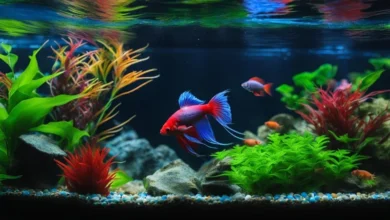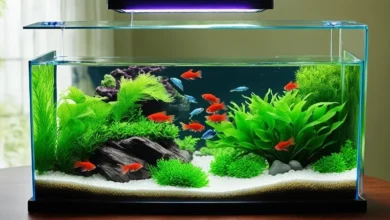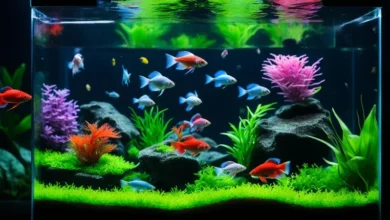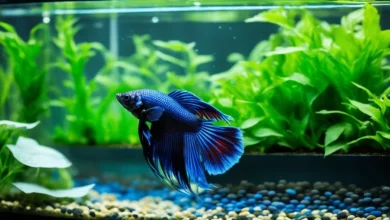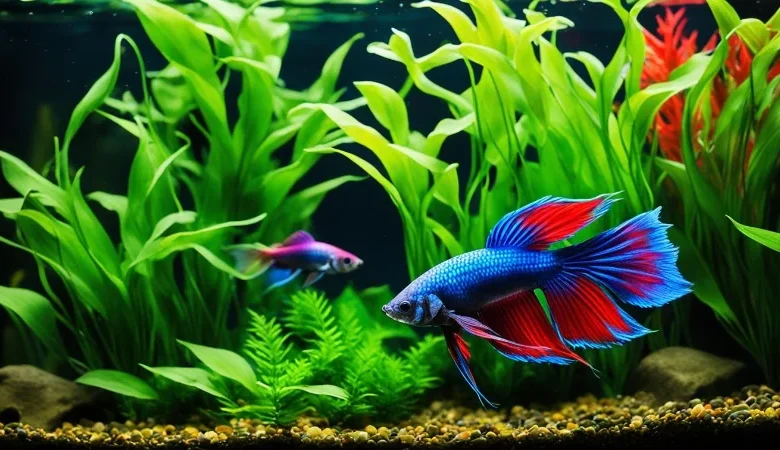
Can the vibrant colors and graceful movements of betta fish harmoniously coexist with the shimmering shoals of neon tetras in a single aquatic habitat? While it may seem unlikely, this combination has piqued the curiosity of many aquarium enthusiasts. The question is, can these two species create a vibrant community in your aquarium?
In this article, we will delve into the compatibility between betta fish and neon tetras, exploring the essentials of maintaining a harmonious aquatic environment. We will uncover the temperament of betta fish and discuss how to create a safe and stimulating environment. Additionally, we will shed light on the schooling nature of neon tetras and how it can influence their behavior. Join us on this journey as we unravel the secrets of fostering a vibrant community with betta fish and neon tetras.
Introducing Betta Fish to Neon Tetras
When it comes to creating a vibrant community tank, introducing betta fish to neon tetras can be a great combination. However, it is essential to take certain steps to ensure a smooth transition and harmonious environment for both species.
Assessing the Temperament of Your Betta
Before introducing your betta fish to neon tetras, it is crucial to assess your betta’s temperament. Betta fish can vary in their aggression levels, so it is essential to choose a betta with a peaceful temperament. This will increase the chances of successful cohabitation with neon tetras, ensuring a stress-free environment for all.
Creating a Safe and Stimulating Environment
Setting up a safe and stimulating environment is vital to the well-being of both betta fish and neon tetras. Ensure you provide plenty of hiding spots and areas for exploration, using live plants, caves, or decorations. This will help reduce stress and provide a sense of security for both species.
Understanding Neon Tetra’s Schooling Nature
Neon tetras are schooling fish that thrive in groups. They feel more secure and display their beautiful colors when kept in numbers. Consider having at least six neon tetras in the aquarium to provide an optimal social environment. The presence of fellow tetras will make them feel more comfortable and help discourage any potential bullying behavior from the betta fish.
By carefully assessing the temperament of your betta fish, creating a safe and stimulating environment, and understanding the schooling nature of neon tetras, you can successfully introduce bettas to neon tetras and create a vibrant community in your aquarium.
Betta Fish with Neon Tetras Living Conditions
Creating the ideal living conditions for betta fish and neon tetras is crucial for their health and well-being. In this section, we will discuss the importance of tank size and layout, optimal water parameters, and setting up an appropriate filtration system to ensure a thriving aquatic environment.
The Importance of Tank Size and Layout
Proper tank size plays a vital role in providing enough space for both betta fish and neon tetras to swim and thrive. For a community tank containing these species, a minimum tank size of betta fish tank size is recommended. However, the larger the tank, the better it will be for their overall well-being. A larger tank provides more room for the fish to establish territories and reduces the chance of aggression.
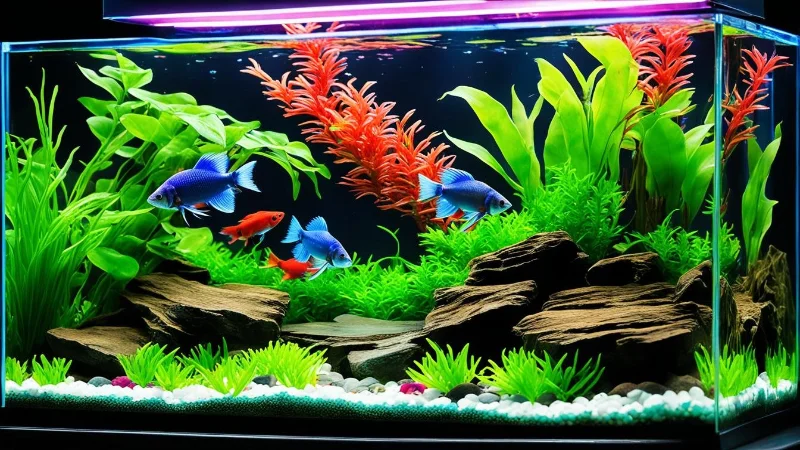
When it comes to tank layout, it is essential to create hiding spots and areas for the fish to explore. The inclusion of live plants, rocks, driftwood, and artificial decorations can provide ample hiding places for both betta fish and neon tetras. These hiding spots help reduce stress and allow the fish to exhibit their natural behaviors. Also, betta fish and neon tetras thrive in well-maintained habitats with neon tetra tank conditions.
Optimal Water Parameters for Both Species
Maintaining proper water parameters is crucial for the health and well-being of betta fish and neon tetras. The recommended temperature for a community tank with these species ranges from water range. Ph levels should be maintained within pH range for both betta fish and neon tetras to thrive. Additionally, regular monitoring of ammonia, nitrite, and nitrate levels is essential to ensure a safe and healthy environment.
Setting Up an Appropriate Filtration System
One key factor in maintaining water quality and cleanliness is setting up an effective filtration system. An aquarium filtration system is crucial to remove waste, toxins, and harmful chemicals that can build up in the tank. Make sure to choose a filtration system suitable for the tank size and consider adding a sponge filter to minimize water flow and prevent betta fish from being stressed by strong currents.
Having the right tank size, layout, water parameters, and filtration system will contribute to a harmonious and thriving environment for both betta fish and neon tetras. Creating an optimal living condition ensures the well-being and happiness of these vibrant aquatic species.
Aquarium Setup and Design for a Thriving Community
Creating the perfect habitat for your betta fish and neon tetras involves careful consideration of the tank setup and design. By providing a harmonious environment, you can ensure the well-being and happiness of your aquatic community.
One of the key elements of an ideal setup is choosing the right plants, decorations, substrate, and lighting. Plants not only enhance the aesthetic appeal of the tank but also serve as hiding spots and provide shade for the fish. Opt for aquarium-safe plants such as Java Fern, Anubias, or Amazon Sword, which can thrive in a variety of water conditions.
When selecting decorations, keep in mind the needs of both the betta fish and neon tetras. Avoid sharp or abrasive objects that could injure their delicate fins. Instead, opt for smooth rocks, driftwood, or PVC pipes to create hiding spots and shelter. These elements will help alleviate stress and promote a natural environment for your fish.
Choosing the right substrate is crucial for maintaining water quality and mimicking the natural habitat of your fish. Avoid sharp gravels that may cause injuries to the fish. Opt for fine sand or smooth pebbles to create a comfortable and safe tank floor.
The lighting in your aquarium plays a vital role in the overall health and behavior of your betta fish and neon tetras. Aim for a soft, subdued lighting setup that replicates their natural environment. This will not only create a visually appealing tank but also reduce stress and encourage natural behaviors.
While setting up your tank, it’s essential to create hiding spots and shelter for your fish. This is particularly important for betta fish, as they appreciate secluded areas. Use plants, decorations, or rock formations to create caves or dense vegetation where the fish can retreat when they need privacy. By providing these hiding spots, you will help alleviate stress and foster a sense of security among your fish.
To maintain water quality, regular maintenance and proper filtration are essential. Invest in a filtration system that can handle the tank size and provides adequate mechanical, chemical, and biological filtration. Regular water changes and monitoring of water parameters will ensure a healthy and thriving aquatic community.
By following these guidelines for aquarium setup and design, you can create a thriving community of betta fish and neon tetras. Providing them with a safe and stimulating environment will not only enhance their well-being but also bring vibrant life and beauty to your home.
Dietary Management for Healthy Betta Fish and Neon Tetras
Proper nutrition is crucial for maintaining the health and vitality of your betta fish and neon tetras. Each species has specific dietary requirements that must be met to promote optimal growth and well-being.
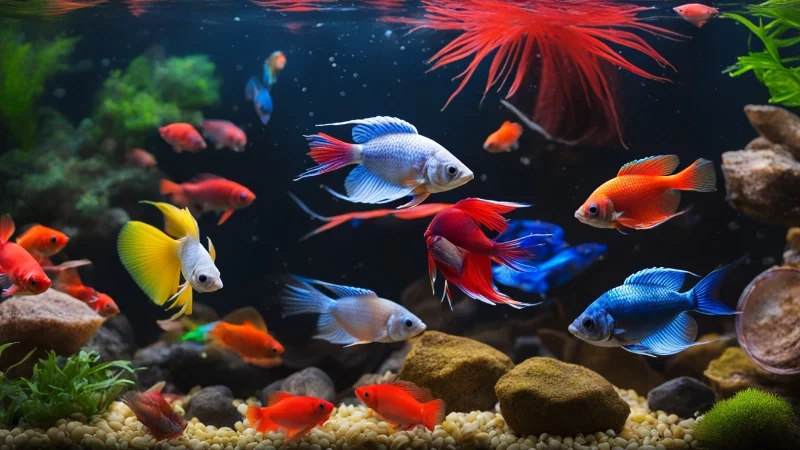
Betta Fish Diet
Betta fish are carnivorous and thrive on a high-protein diet. They require a variety of foods to ensure they receive essential nutrients. You can feed your bettas a combination of high-quality pellets, flakes, frozen or live foods such as bloodworms, brine shrimp, and daphnia.
It is important to note that overfeeding betta fish can lead to obesity and health issues. Feed them small, frequent meals that they can consume within two minutes, and remove any uneaten food to maintain water quality.
Neon Tetra Diet
Neon tetras are omnivorous and need a balanced diet of both protein and plant-based foods. They can be fed high-quality flake or pellet food designed for tropical fish. Supplement their diet with small live or frozen foods like brine shrimp, daphnia, and micro worms to provide variety and enhance their overall health.
Offering vegetables like blanched spinach or lettuce leaves can also be beneficial, as it simulates their natural diet in the wild and provides additional nutrients.
When introducing new food to your fish, make sure to observe their response and adjust accordingly. All fish have different preferences, so it may take some experimentation to determine their favorite foods.
Feeding Betta Fish and Neon Tetras
To ensure your fish receive proper nutrition, it is essential to establish a regular feeding schedule. Feed your bettas and neon tetras at least once or twice a day but in small portions. This helps prevent overfeeding and maintains good water quality in the aquarium.
Remember to remove any uneaten food after each feeding to prevent it from decomposing and causing water contamination. It is also advisable to perform regular water changes to keep the aquarium environment clean and healthy for your fish.
Incorporating a varied and balanced diet into your betta fish and neon tetra’s feeding routine will contribute to their overall health, vibrant colors, and longevity.
Choosing Compatible Tank Mates Beyond Betta Fish and Neon Tetras
In addition to betta fish and neon tetras, there are several other species that can peacefully coexist in your aquarium. By carefully selecting compatible tank mates, you can create a harmonious community tank that showcases the beauty and diversity of aquatic life. In this section, we will explore some peaceful and beneficial invertebrates that are well-suited for aquarium life.
Selecting Peaceful and Beneficial Invertebrates
When choosing invertebrates to add to your community tank, it’s important to consider their compatibility with betta fish and neon tetras. Opt for species that are known to be peaceful and have minimal aggression tendencies. Here are a few examples of invertebrates that make excellent tank mates:
- Amano Shrimp (Caridina multidentata): These shrimp are peaceful and can help keep your tank clean by feeding on algae and organic debris. They are compatible with betta fish and neon tetras due to their non-aggressive nature.
- Nerite Snails (Neritina sp.): Snails like the Nerite snails are excellent algae eaters and have a calm temperament. They won’t interfere with the betta fish or neon tetras, making them a suitable addition to your community tank.
- Cherry Shrimp (Neocaridina davidi): Cherry shrimp are known for their vibrant red coloration and peaceful nature. They are generally able to coexist well with betta fish and neon tetras, as long as there are plenty of hiding places in the tank.
These peaceful invertebrates not only add visual interest to your aquarium but also contribute to its overall health by assisting in algae control and waste management.
Avoiding Aggression: Keeping Harmony in the Tank
While some betta fish may tolerate certain tank mates, it’s crucial to be mindful of their territorial behavior. Betta fish are known for their aggression, especially towards other bettas or fish with long, flowing fins. To maintain harmony in your community tank, consider the following tips:
- Provide ample hiding places and visual barriers using plants, rocks, and decorations. This allows each fish to establish their own territory and reduces the likelihood of aggressive encounters.
- Monitor the behavior of your betta fish closely. If any signs of aggression or stress are detected, consider removing incompatible tank mates immediately.
- Ensure that the aquarium is adequately sized to accommodate the needs of multiple fish species. Overcrowding can lead to territorial disputes and increased stress levels, so it’s essential to choose an appropriately sized tank.
By carefully selecting peaceful invertebrates as tank mates and implementing strategies to minimize aggression, you can successfully maintain harmony in your community tank and provide a thriving environment for all its inhabitants.
Conclusion
In conclusion, creating a vibrant community by pairing betta fish with neon tetras is indeed possible. However, it requires proper care, attention to tank conditions, and an understanding of compatibility between these two species.
To ensure success, it is essential to assess the temperament of your betta fish and provide a safe and stimulating environment that caters to the needs of both species. Paying attention to the schooling nature of neon tetras and creating an appropriate tank setup and design are crucial for their well-being.
Remember, maintaining the optimal living conditions through tank size, water parameters, and filtration is essential for the overall health of betta fish and neon tetras. Additionally, providing a balanced and suitable diet is vital to keeping both species healthy.
By carefully selecting compatible tank mates and avoiding aggression, you can create a harmonious community in your aquarium. Keep in mind that each fish has its own personality, so occasional monitoring and adjustments may be necessary.
With proper care and attention, creating a vibrant community with betta fish and neon tetras can be a rewarding experience. So go ahead and embark on this aquatic adventure, and enjoy the beautiful sight of these stunning species coexisting harmoniously in your tank!
FAQ
Can betta fish and neon tetras be kept together?
Yes, it is possible to keep betta fish and neon tetras together in the same tank. However, there are some important factors to consider for successful cohabitation.
How do I assess the temperament of my betta fish?
To assess the temperament of your betta fish, observe its behavior towards tank mates. If your betta fish displays aggression towards other fish, it may not be suitable to house them with neon tetras.
What should I do to create a safe and stimulating environment for betta fish and neon tetras?
To create a safe and stimulating environment, provide ample hiding spots and vegetation for both species. This helps reduce stress and provides them with places to retreat if needed.
Why is the schooling nature of neon tetras important?
Neon tetras are schooling fish, meaning they prefer to live in groups. The presence of a school of neon tetras can help alleviate stress in both betta fish and neon tetras in a shared tank.
What are the optimal tank conditions for betta fish and neon tetras?
Betta fish and neon tetras thrive in tanks that are adequately sized and have suitable layouts. A tank size of at least 10 gallons is recommended. Additionally, create an environment that mimics their natural habitat with the right water parameters and proper filtration system.
How should I set up an appropriate filtration system for my betta fish and neon tetras?
Use a filtration system that provides both mechanical and biological filtration. This helps maintain water quality and keeps it free from harmful toxins.
What factors should I consider when setting up an aquarium for a betta fish and neon tetra community?
When setting up your aquarium, consider elements such as choosing the right plants, decorations, substrate, and lighting to create a harmonious environment. Provide hiding spots and shelter for both species.
What do betta fish and neon tetras eat?
Betta fish are carnivores and require a diet primarily consisting of high-quality betta pellets and occasional live or frozen foods. Neon tetras, on the other hand, are omnivores and can be fed a varied diet of high-quality flakes, pellets, and small live or frozen foods.
Are there any compatible tank mates for betta fish and neon tetras?
Yes, there are compatible tank mates for betta fish and neon tetras. Peaceful and beneficial invertebrates such as snails and shrimp can coexist with these species. Avoid aggressive or territorial species that may cause conflict.
How can I prevent aggression and maintain harmony in the tank?
Providing ample hiding spots and visual barriers can help reduce aggression. Additionally, maintaining a suitable tank size, keeping the tank well-maintained, and avoiding overcrowding can help promote harmony among the fish.
